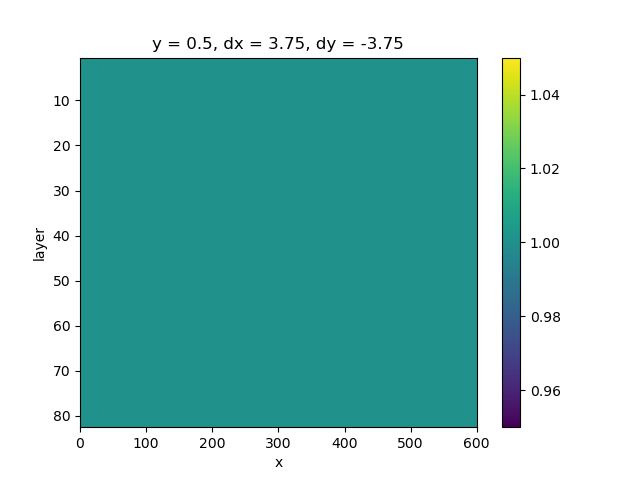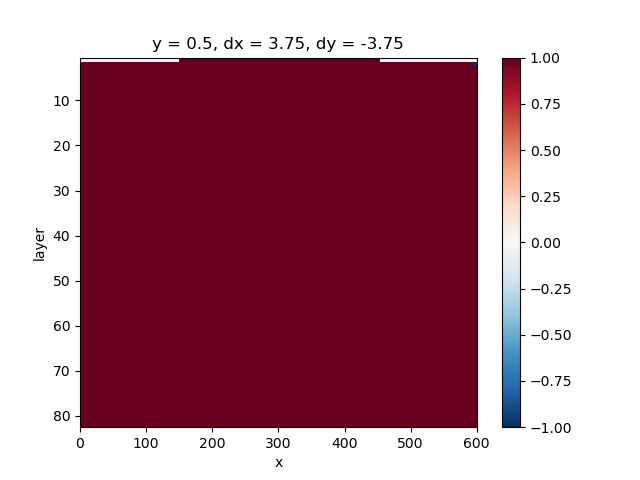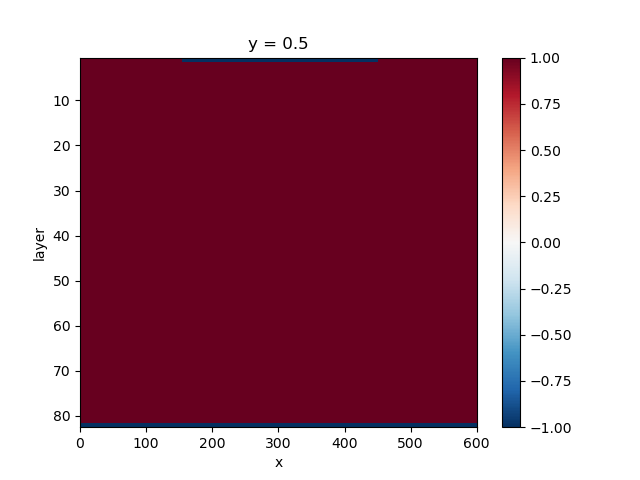Note
Go to the end to download the full example code.
Elder#
The classic 2D Elder problem demonstrates free convection. Traditionally this was created for heat transport, but we use a modified version for salt transport. The conceptual model can be seen as a 2D sand box, with on top a salt lake in the center and fresh lakes on both the outer edges of the top row.
More info about the theory behind the Elder problem:
Simpson, J., & Clement, P. (2003). Theoretical analysis of the worthiness of Henry and Elder problems as benchmark of density-dependent groundwater flow models. Advances in Water Resources, 1708 (02). Retrieved from https://www.sciencedirect.com/science/article/abs/pii/S0309170802000854
We’ll start with the usual imports
import matplotlib.pyplot as plt
import numpy as np
import xarray as xr
import imod
Discretization#
We’ll start off by creating a model discretization, since
this is a simple conceptual model.
The model is a 2D cross-section, hence nrow = 1.
nrow = 1
ncol = 160
nlay = 82
dz = 1.875
dx = 3.75
dy = -dx
setup tops and bottoms
top1D = xr.DataArray(
np.arange(nlay * dz, 0.0, -dz), {"layer": np.arange(1, nlay + 1)}, ("layer")
)
bot = top1D - dz
top = nlay * dz
Set up ibound, which sets where active cells are (ibound = 1.0)
bnd = xr.DataArray(
data=np.full((nlay, nrow, ncol), 1.0),
coords={
"y": [0.5],
"x": np.arange(0.5 * dx, dx * ncol, dx),
"layer": np.arange(1, 1 + nlay),
"dx": dx,
"dy": dy,
},
dims=("layer", "y", "x"),
)
fig, ax = plt.subplots()
bnd.plot(y="layer", yincrease=False, ax=ax)

<matplotlib.collections.QuadMesh object at 0x0000019B38A326F0>
Boundary Conditions#
Set the constant heads by specifying a negative value in iboud,
that is: bnd[index] = -1`
bnd[0, :, 0:40] = 0
bnd[0, :, 121:160] = 0
bnd[1, :, 0] = -1
bnd[1, :, 159] = -1
fig, ax = plt.subplots()
bnd.plot(y="layer", yincrease=False, ax=ax)

<matplotlib.collections.QuadMesh object at 0x0000019B357E6C00>
Define the icbund, which sets which cells in the solute transport model are active, inactive or constant.
icbund = xr.DataArray(
data=np.full((nlay, nrow, ncol), 1.0),
coords={
"y": [0.5],
"x": np.arange(0.5 * dx, dx * ncol, dx),
"layer": np.arange(1, nlay + 1),
},
dims=("layer", "y", "x"),
)
icbund[81, :, :] = -1
icbund[0, :, 41:120] = -1
fig, ax = plt.subplots()
icbund.plot(y="layer", yincrease=False, ax=ax)

<matplotlib.collections.QuadMesh object at 0x0000019B2F1E4050>
Initial Conditions#
Define the starting concentration
sconc = xr.DataArray(
data=np.full((nlay, nrow, ncol), 0.0),
coords={
"y": [0.5],
"x": np.arange(0.5 * dx, dx * ncol, dx),
"layer": np.arange(1, nlay + 1),
},
dims=("layer", "y", "x"),
)
sconc[81, :, :] = 0
sconc[0, :, 41:120] = 280.0
fig, ax = plt.subplots()
sconc.plot(y="layer", yincrease=False, ax=ax)

<matplotlib.collections.QuadMesh object at 0x0000019B2426C530>
Build#
Finally, we build the model.
m = imod.wq.SeawatModel("Elder")
m["bas"] = imod.wq.BasicFlow(ibound=bnd, top=top, bottom=bot, starting_head=0.0)
m["lpf"] = imod.wq.LayerPropertyFlow(
k_horizontal=0.411, k_vertical=0.411, specific_storage=0.0
)
m["btn"] = imod.wq.BasicTransport(
icbund=icbund, starting_concentration=sconc, porosity=0.1
)
m["adv"] = imod.wq.AdvectionTVD(courant=1.0)
m["dsp"] = imod.wq.Dispersion(longitudinal=0.0, diffusion_coefficient=0.308)
m["vdf"] = imod.wq.VariableDensityFlow(density_concentration_slope=0.71)
m["wel"] = imod.wq.Well(id_name="wel", x=0.5 * dx, y=0.5, rate=0.28512)
m["pcg"] = imod.wq.PreconditionedConjugateGradientSolver(
max_iter=150, inner_iter=30, hclose=0.0001, rclose=0.1, relax=0.98, damp=1.0
)
m["gcg"] = imod.wq.GeneralizedConjugateGradientSolver(
max_iter=150,
inner_iter=30,
cclose=1.0e-6,
preconditioner="mic",
lump_dispersion=True,
)
m["oc"] = imod.wq.OutputControl(save_head_idf=True, save_concentration_idf=True)
m.create_time_discretization(additional_times=["2000-01-01T00:00", "2020-01-01T00:00"])
Now we write the model
modeldir = imod.util.temporary_directory()
m.write(modeldir, resultdir_is_workdir=True)
Run#
You can run the model using the comand prompt and the iMOD-WQ executable. This is part of the iMOD v5 release, which can be downloaded here: https://oss.deltares.nl/web/imod/download-imod5 . This only works on Windows.
To run your model, open up a command prompt and run the following commands:
cd c:\path\to\modeldir
c:\path\to\imod\folder\iMOD-WQ_V5_3_SVN359_X64R.exe Elder.run
Note that the version name of your executable might differ.
Visualise results#
After succesfully running the model, you can plot results as follows:
head = imod.idf.open(modeldir / "results/head/*.idf")
fig, ax = plt.subplots()
head.plot(yincrease=False, ax=ax)
conc = imod.idf.open(modeldir / "results/conc/*.idf")
fig, ax = plt.subplots()
conc.plot(levels=range(0, 35, 5), yincrease=False, ax=ax)
Total running time of the script: (0 minutes 1.953 seconds)